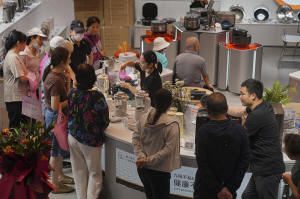China gets boost in retail sales as export goods stay home, while
tariffs hit factory output
[June 16, 2025] By
ELAINE KURTENBACH
BANGKOK (AP) — China's economy managed a mixed economic performance in
May, as retail sales jumped while factory output slowed in the face of
higher U.S. tariffs.
Data released Monday showed retail sales rose 6.4% from a year earlier,
helped partly by promotions of products stranded as shipments were
suspended due to higher tariffs.
A major online shopping festival also helped entice consumers to spend
more. The June 18 shopping extravaganza started last month, with online
sellers offering discounts on many products.
But factory output and exports still took a hit from the tariffs, even
though many of the increases in import duties have been delayed as
Beijing and Washington negotiate a trade deal.
Manufacturing output rose 5.8% in May year-on-year, the National Bureau
of Statistics said, compared with 6.1% in April and 7.7% in March.
Factory activity surged earlier in the year but has slowed as U.S.
President Donald Trump's tariffs took effect.
China earlier reported its exports to the United States fell 35% in May
from a year earlier, while total exports rose 4.8% in May from a year
earlier, much lower than economists’ forecasts and down sharply from an
8.1% jump in April.

Overall, economists said the world’s second largest economy had
weathered the threat of hikes in tariffs relatively well.
But signs of weakness persist as a slump in the property market has yet
to reverse.
Deflation remains an issue, with consumer prices slipping 0.1% in May
from a year earlier and 0.2% from the month before.
Investment in real estate fell 10.7% in January-May compared to a year
earlier, with housing prices in most cities falling slightly, the report
showed.
[to top of second column] |

Residents gather to watch a worker demonstrating a juice mixer
machine at a newly opened Chinese e-commerce platform JD.com
shopping mall in Beijing, Monday, June 16, 2025. (AP Photo/Andy
Wong)

Spending on factory equipment and other fixed assets rose at a
relatively slow 3.7% annual pace, it said.
Apart from the “618” online shopping festival timed to celebrate the
June 18, 1998, founding of e-commerce giant JD.com, China’s program to
subsidize trade-ins of household appliances, autos and other goods
helped boost retail sales.
But while retail sales rose 5% in January-May from a year earlier,
consumers remain wary given weakness in the property sector, a vital
repository of wealth for most families, Lynn Song of ING Economics said
in a report.
May's data was encouraging, she said, “However, a more sustainable
consumption recovery will likely require a turnaround of consumer
confidence, which remains much closer to historical lows than historical
averages.”
The threat of higher tariffs that could further disrupt trade between
the two biggest economies, remains, with an Aug. 10 deadline for
reaching an agreement following talks last week in London.
“With tariffs set to stay elevated and exporters facing broader
constraints, export growth is likely to slow further by year-end,”
Zichun Huang of Capital Economics wrote in a commentary.
All contents © copyright 2025 Associated Press. All rights reserved
 |